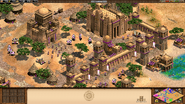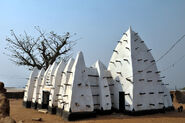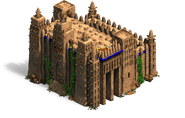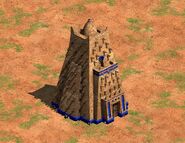Template:Ctabs Template:Infobox Civ

The Wonder of the Malians, the Great Mosque of Djenné
The Malians are an African civilization featured in Age of Empires II HD: The African Kingdoms. They are based on various pre-colonial kingdoms in West Africa, primarily the Mali Empire (Manden Kurufaba).
Historically, the Malians were known for their very progressive society that put emphasis on education; it was one of the largest educational centers in the world that brought scholars from China, the Middle East, and Europe. To highlight this achievement, their team bonus increases the research speed for University technologies.
West African cultures (especially the Dahomey Kingdom) held women in high esteem, with local women even participating in the military. This is highlighted with their unique unit, the Gbeto, which is noted as the only trainable female military unit. In real history, Gbetos or Dahomey Amazons were usually equipped with rifles. Although in-game Gbetos don't use rifles as their weapons, the Malians have access to various gunpowder units.
The Mali and Songhai empires were known to be some of the wealthiest kingdoms in Africa; this was primarily due to the enormous natural wealth at their disposal from gold and salt mines, as well as their effective control of the trans-Saharan trade routes that carried valuable resources to and from the region. To highlight this, the Malians gain Gold Mining upgrades for free and have access to every Market upgrade.
West Africa and the Sahel have sparse vegetation, with few trees. These limited resources meant that the Malians didn't have as much of a reliance on lumber in their architecture (instead primarily utilizing clay and mud bricks). This is represented in-game with a -15% wood cost for all Malian buildings. Famous examples of this architectural style include the University of Sankore and the Great Mosque of Djenne (the Malian Wonder).
Horses played an important role on Western African cultures for centuries, with the Malians are known for their tactical use in combat; while Malian cavalry are not well equipped than their European counterparts, their effective leadership and raiding tactics makes them a force to be reckoned with. This is represented in-game with the fact that while the Malians' Stable cannot upgrade the Light Cavalry to Hussar and Cavalier to Paladin, but one of their unique technologies, Farimba, gives Malians' Stable units +5 attack, giving them one of the best Cavaliers in the game. In history, Farimba was a title for the military nobility of the empire, which commanded the cavalry in Malian armies.
Many foot soldiers in West Africa were fierce in combat, and often won battles with their superior coordination and maneuverability. This is highlighted with their bonus where infantry units from barracks gain additional pierce armor per age starting in Feudal Age. The bonus in this case could be in line with the high pierce armor of units like the Eagle Warrior and Tarkan, where it refers more to the general inaffectiveness of archers against the unit (e.g. because of their swiftness), rather than actual armor.
Description
Follow in the footsteps of the great Mansa Musa and become the greatest king of Western Africa. Conquer surrounding kingdoms to expand your wealth and hold a firm grip on the trade routes that zigzag through the region. Will you be able to keep the once hostile provinces united under your crown?
Overview
A Feudal Age Malian village.
Unique Unit: Gbeto (ranged infantry)
Unique Tech: Tigui (ungarrisoned Town Centers fire arrows), Farimba (Stable units +5 attack)
Civilization bonuses
- Buildings cost -15% wood (except Farms)
- Barracks units +1 pierce armor per Age (starting from Feudal Age)
- Gold Mining and Gold Shaft Mining, free
- Team Bonus: University researches +80% faster
In-game dialogue language (Bambara)
- N be nà (I come)
- N y'a men (I understand)
- Taabaa (goer- also said by the female villager when ordered to build)
- ɔwɔ (yes)
- Chi ko?
- Keroke (attack)
- Gukakabu
AI Player Names
- Abu Bakr II - (fl. 14th century), also spelled Abubakri and known as Mansa Qu, may have been the ninth mansa ("king of kings") of the Mali Empire. He succeeded his nephew Mansa Mohammed ibn Gao and preceded Mansa Musa. Abu Bakr II abdicated his throne in order to explore "the limits of the ocean".
- Mamadou - Mansa Mahmud II, also known as Mamadou, was mansa of the Mali Empire from 1481 to 1496.
- Mansa Mahmud IV - the last great emperor of the Mali Empire according to the Tarikh al-Sudan, the West African chronicle written in Arabic in around 1655 by Abd al-Sadi.
- Mansa Musa - (c. 1280 – c. 1337) was the tenth Mansa, which translates as "sultan" (king), "conqueror", or emperor of the West African Mali Empire.
- Mansa Sakura - (died c. 1300) was the sixth mansa of the Mali Empire.
- Mari Djata I - the same as Sundjata according to Ibn Khaldun, a North African Arab historiographer and historian, in the late 14th century.
- Ouali Keita - Mansa Uli, also known as Ali or Wali in Arab sources, was the second mansa of the Mali Empire.
- Soumaba Cisse - a monarch of Ghanaian Empire, ally of Sundjata Keita: 1235–1240.
- Soumaoro Kante - Soumaoro Kanté, also known as Sumanguru was a 13th-century king of the Sosso people. Seizing Koumbi Saleh, the capital of the recently defunct Ghana Empire, Soumaoro Kanté proceeded to conquer several neighboring states, including the Mandinka people in what is now Mali.
- Sundjata - Was a puissant prince and founder of the Mali Empire. The famous Malian ruler Mansa Musa who made a pilgrimage to Mecca was his grandnephew.
- Tiramakhan - a 13th-century general in the Mali Empire who served under Sunjata Keita. Traore expanded the power of Mali westward and set up the Kabu Empire.
Trivia
- The African architecture set shared by the Malians and Ethiopians is based on the Sudano-Sahelian architecture, with elements of Aksumite architecture in the Imperial Age.
- The design for the Malian wonder is anachronistic by necessity. It is based on the current appearence of the Great Mosque of Djenne, but the mosque had been rebuilt in the early 20th century. The original mosque would likely have looked different, but no records exist that describe its appearence, so it remains unknown. The architect for the original mosque was from Egypt, so it is possible that it would have been similar to medieval Egyptian mosques in appearence.
- The Malians are the only civilization that lacks the final attack upgrades for both melee and ranged units at the Blacksmith (namely Blast Furnace and Bracer).
- They are also the only civilization having access to Siege Onagers but not Siege Engineers





